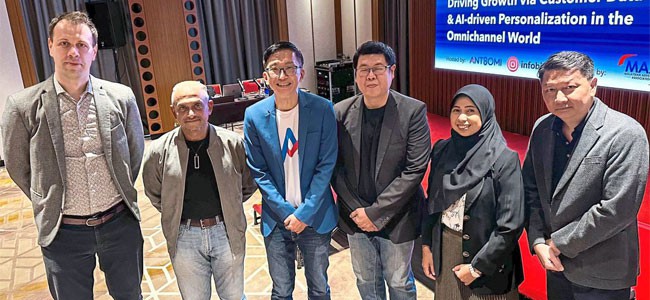INDUSTRY bodies require mature, experienced, ultra-committed professionals at the helm, if they intend to contribute efficiently and meaningfully, besides facilitating development. Former driver of L’Oreal’s efforts in Europe, WFA-CEO Stephan Loerke (pix) is a savvy professional with definite vision derived from battle-hardened “real-life marketing experience” across several environments and continents. Simultaneously retaining a deep interest in socio-political affairs, he is a keen observer of the factors influencing consumer behavioural evolution across societies. In an intense zweisprachiges (bilingual) Skype conversation with theSun CMO Prashun Dutt, he shared meaningful insights on WFA’s vision and priorities for GMC 2016 (published yesterday) and explored the major issues and closer-to-the-ground realities which are influencing and coercing the evolution of marketing in an increasingly connected era.
THREE CRITICAL FACTORS
Marketers, including established blue-chip corporations, are being coerced to review, adapt, evolve, experiment or even re-invent their marketing equation by three catalyst factors:
1) Technology and digital/social connectivity:
We are now living in a borderless world, with unrestricted flow of multi-tiered information and influencing factors. While largely positive, this also postulates risks, contradictions, anomalies, fragmentation, disruptions and even deep-dark-web dangers.
This is coercing marketers to encounter and manage a wider set of issues and challenges, beyond the simple focus on brand, category and competition. Marketers must acquire required competence/skills to engage customers and stake-holders in multiple conversations across both traditional and dynamic communication modes.
2) Society and changing consumer mind-sets:
Society in general is becoming more demanding with brand owners. “Consumers today firmly believe that brands have a specific responsibility which goes far beyond producing a good quality product”. Thus “product differentiation alone can no longer offer sustainable advantage”. For continued success “…brands must also simultaneously engage people’s heads and hearts”.
3) Total globalisation is a myth:
Even established blue-chip multi-national players must accept and respect the adaptability and colouring precipitated by local factors, socio-political/cultural issues, attitudes and sentiments.
MARKETING CANVAS: GLOBAL vs G-LOCAL
While the world is increasingly connected and everything feels like a village, one must still accept the reality that most people have not yet become global citizens.
They are still local citizens, local consumers with localised issues, priorities and sentiments. These specifics have become even more important. Thus global brands must adapt their core principles and priorities to manage the tension between the expectations of global consistency and local relevance. Marketers must craft and manage their own equations of being simultaneously GLOBAL and G-LOCAL.
Simultaneously, those attempting to hide their limitations with the excuse “…this is Malaysia, Indonesia, India or China”must accept that their job, industry and competition standards are no longer local. They are measured by regional, international and global yardsticks. There is no formula for achieving this delicate balance, it is more like a Tao.
DEFUSING THE “GAP AND MISTRUST”
We attend marketing conferences and openly celebrate:
• the advent of big data;
• the gaining of insights on a scale like never before; and
• ultimately shape and manage dialogues with individuals, which is “more relevant than ever before”.
Then, on speaking with our wives, mothers, sisters, families, friends, NGOs and regulators, we hear a very different perception of our industry. There is a lot of mistrust at times plus anxieties, which are shaping the way people look at marketing and that trust deficit is actually increasing.
WFA is determined to facilitate bridging of this gap. We want to be projecting ourselves into the future with an aspiration to bring purpose back into marketing. We feel that there are unique opportunities going forward.
• For brand owners to be rethinking the way they look at marketing,
• to aspire not only to just generate value for people or consumers,
• but more generally for society, and earn due respect,
• ultimately becoming winners in the marketplace by executing these tasks.
TACKLING DIGITAL CHALLENGES AND CONVERSATIONS
Many brands will struggle to engage with people – to get their attention and engage them to interact. People will ultimately be in charge of deciding if they want to engage with the brand or not, whether they want to spend time with the brand or not. Brands increasingly will need to find relevance in justifying people finding time for them.
WFA has noted some interesting cases, though relatively small-scale, which clearly indicate that some brand owners are taking on bigger challenges and are prepared to stand for more than just producing safe and quality products. They are prepared to stand for something more, to create purpose in the way they conduct their business.
In the digital age such brands are winning because “…they are creating excitement, they are creating advocates, they are creating fans, they are creating buzz”. They are “actually able to leverage that pressure and that energy among people”.
FOUR Ps OF GREAT DIGITAL AND SOCIAL MARKETING
People: Focus on people; not only on content, media or technology.
Purpose: Do not just make better things; make things better.
Principles: Use your brand’s values to deliver meaningful value.
Participation: Do not interrupt people; engage and involve them.
THREE VITAL NEEDS
• Need for agility, openness and speed. Something you do not necessarily have in big established merchant corporations which have “entrenched values, processes and certainties”. In this evolving era, we “actually need a bit of the opposite”. We need people who have diverging points of view and come from different cultures. Minds cultivated in diversity are better equipped to take on challenges.
• Self confidence to manage contradictions and disruption, yet avoiding arrogance and complacency.
• Ability to leverage the skills and competence in marketing to consumers and simultaneously provide value to society.
NET “TAKE-OUT”
Disruption of the old, comfortable status-quo is inevitable. If marketers do not themselves evolve and re-invent, competitors and consumers will disrupt the equation. To succeed in this rapidly evolving connected era, marketing professionals must learn to manage discomfort. Besides excelling in the “art of disruption”.
WFA VISION
WFA is essentially an organisation that offers an exchange platform for companies and professionals, a “global network of peers”.
WFA provides professional platforms where they can talk very openly in terms of how they look at things. To discuss and understand differing perspectives of similar professionals from other environments, how they work differently to achieve almost similar objectives.
WFA desires to help marketers:
• become less complacent;
• examine the holistic picture and understand what people think of them; and
• project themselves into a future where marketing will stand for good, socially relevant purpose, besides market-share and profit aspirations.
FIVE LEVERS FOR CHANGE
theSun recommends that serious marketers study Unilever’s Five Levers for Change as a paradigm example to appreciate how these tasks can be achieved. Inspiring sustainable living and constructively influencing marginal changes in people’s habits while simultaneously focusing on defined marketing objectives.
*Source from theSundaily – 17 March 2016
View more MAA & WFA Global Marketer Conference 2016: http://www.wfanet.org/KL/



